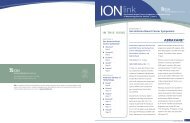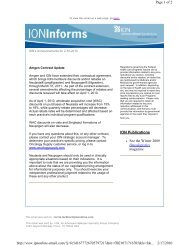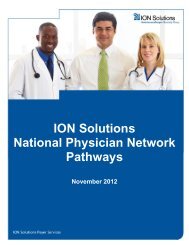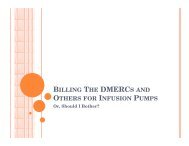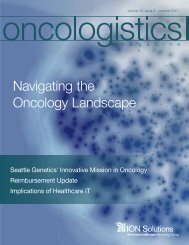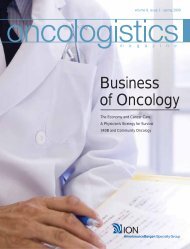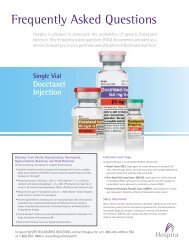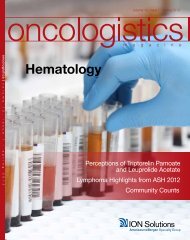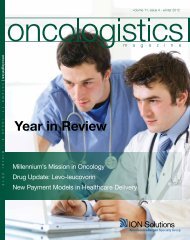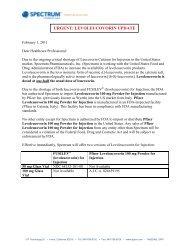drug updateoncologistics volume 7, issue 1 - spr<strong>in</strong>g <strong>2008</strong> 32PROLONGED SURVIVAL IN HIGHER-RISK MDSFrom Abstract #817 <strong>in</strong> Blood, Volume 110, Issue 11,November 16, 2007A previous Cancer and Leukemia Group B (CALGB) trial,CALGB 9221, showed a positive overall survival (OS)trend with Vidaza versus best supportive care (BSC)<strong>in</strong> MDS patients. With this <strong>in</strong> m<strong>in</strong>d, a new Phase III,<strong>in</strong>ternational, multicenter, randomized, prospective trialwas <strong>in</strong>itiated to demonstrate the superiority of Vidazaplus BSC over conventional care regimens (CCR) plusBSC for prolong<strong>in</strong>g OS. In this study, only higher-riskMDS patients—those present<strong>in</strong>g with a FAB defi ned asRAEB, RAEB-T, or CMML (10-29% marrow blasts) withan IPSS of Int-2 or High by central pathology/cytogeneticreview—were eligible.Before randomization, trial participants chose amongone of three conventional care regimens: BSC only,low-dose ara-C (LDAC, 20 mg/m 2 /d x 14d, q 28d), orstandard chemotherapy. Patients were then stratifi ed byFAB/IPSS and randomized to Vidaza (75 mg/m 2 /d x 7d,q 28d) or CCR. Dur<strong>in</strong>g the trial, Vidaza was adm<strong>in</strong>isteredfor a median of n<strong>in</strong>e cycles and the median follow-upfor OS analysis was 21.1 months. Results showed thatVidaza demonstrated statistically superior OS versusCCR, with a median OS (Kaplan-Meier ) of 24.4 monthsversus 15 months, respectively (p=0.0001). The hazardratio was 0.58 for a 74% OS improvement. There wasa two-fold <strong>in</strong>crease <strong>in</strong> the percent surviv<strong>in</strong>g at 2 yearsfor the Vidaza group, 50.8% compared to 26% for those<strong>in</strong> the CCR group.In the trial, Vidaza was well tolerated, and the safety datawas consistent with previous reports. This trial <strong>in</strong>volv<strong>in</strong>gVidaza was the fi rst MDS cl<strong>in</strong>ical study demonstrat<strong>in</strong>ga signifi cant OS advantage that altered natural diseasecourse, and supports the notion that Vidaza should beconsidered fi rst-l<strong>in</strong>e therapy for higher-risk MDS patients.ALTERNATE DOSING IN MDSFrom Abstract #819 <strong>in</strong> Blood, Volume 110, Issue 11,November 16, 2007At a dos<strong>in</strong>g schedule of 75 mg/m 2 /day subcutaneousfor 7 days every 4 weeks, Vidaza has proven to be aneffective treatment for patients with MDS. However, manypatients, as well as cl<strong>in</strong>icians, would benefi t from theconvenience of a dos<strong>in</strong>g schedule that does not <strong>in</strong>cludeweekend adm<strong>in</strong>istration. The <strong>in</strong>itial phase of an ongo<strong>in</strong>gstudy evaluat<strong>in</strong>g three alternative dos<strong>in</strong>g schedules wasrecently completed.In this Phase II multicenter, open-label trial, MDS patientswere randomized to one of three regimens adm<strong>in</strong>isteredevery 4 weeks for 6 cycles: Vidaza 5-2-2 (75 mg/m 2 /dayx 5 days, followed by 2 days without treatment, followedby 75 mg/m 2 /day x 2 days); Vidaza 5-2-5 (50 mg/m 2 /dayx 5 days, followed by 2 days no treatment, followed by50 mg/m 2 /day x 5 days); or Vidaza 5 (75 mg/m 2 /dayx 5 days). Hematologic improvements were assessedby International Work<strong>in</strong>g Group (IWG) criteria andparticipants with >56 treatment days were evaluablefor response. To determ<strong>in</strong>e whether or not the desiredresponse was ma<strong>in</strong>ta<strong>in</strong>ed after 6 cycles of therapy,a 12-month ma<strong>in</strong>tenance phase us<strong>in</strong>g the Vidaza5 regimen adm<strong>in</strong>istered every 4 or 6 weeks wassubsequently added. Patients who presented with atleast stable disease were eligible to participate <strong>in</strong> thisphase of the study.A total of 151 patients were randomized to treatmentwith Vidaza 5-2-2 (n=50), Vidaza 5-2-5 (n=51), or Vidaza5 (n=50). Of the 139 patients (92%) who received>56 days of treatment and were evaluable for response:74 (49%) completed >6 treatment cycles. Of IWGevaluablepatients, 71 (51%) experienced hematologicimprovements. The proportions of red blood cell (RBC)transfusion-dependent patients who achieved transfusion<strong>in</strong>dependence were Vidaza 5-2-2: 55%, Vidaza 5-2-5:60%, and Vidaza 5: 67%. In FAB low-risk (RA/RARS)transfusion-dependent patients at basel<strong>in</strong>e, RBCtransfusion <strong>in</strong>dependence was reached by 60%, 56%,and 61%, respectively. No treatment-related mortalityhad been reported at the time of the study’s release.Most grades 3 and 4 treatment-related adverse eventswere hematological.Independent of the alternative dos<strong>in</strong>g regimen, theresults of the <strong>in</strong>itial 6-cycle treatment phase demonstratea consistent response for hematologic improvements,
oncologistics drug updateRBC transfusion <strong>in</strong>dependence, and safety profi le acrossa broad range of MDS patients, <strong>in</strong>clud<strong>in</strong>g FAB low-riskpatients. The majority of patients treated <strong>in</strong> this studyto date are lower-risk patients (RA and RARS) and thusthe alternative dos<strong>in</strong>g schedules produce hematologicimprovements and transfusion <strong>in</strong>dependence. The impactof these alternative regimens on survival of higher-riskpatients is unknown and thus these alternative doseregimens cannot be recommended as equivalentsubstitutes for the standard 7 consecutive day regimen.AZACITIDINE (VIDAZA) AND AMLFrom Abstract #1849 <strong>in</strong> Blood, Volume 110, Issue 11,November 16, 2007Approved for MDS by the FDA, Vidaza is also currentlybe<strong>in</strong>g <strong>in</strong>vestigated <strong>in</strong> AML. ATUs are patient-namedprograms launched by French health authorities forpromis<strong>in</strong>g drugs that have yet to be approved. A programis currently ongo<strong>in</strong>g for Vidaza <strong>in</strong> MDS and AML. FromSeptember 2004 through June 2007, 108 AML patientswho had completed one or more courses of Vidazaparticipated <strong>in</strong> the program. The participants receivedVidaza 75 mg/m 2 /d (d 1-7) subcutaneous every 4 weeksfor a m<strong>in</strong>imum of 4 courses.Median age <strong>in</strong> the study was 75 years, with a male tofemale ratio of 66/42. Fifty-one patients had AML withoutand 57 patients with preced<strong>in</strong>g MDS, p-AML and s-AML,respectively. Patients received a median of 4 cyclesof therapy [range 2-16], and response was assessedonly after these 4 cycles, with patients who progressedbefore the exception. As such, 15 patients were not yetevaluable, and of the rema<strong>in</strong><strong>in</strong>g 93 patients, 12 achievedcomplete response, 34 achieved partial response (PR)(OR=49%) and 43 (46%) were considered failure.Four patients died before end of cycle 2, withoutevidence of progression. Thirty-fi ve of the 46 respondersreceived ma<strong>in</strong>tenance therapy after response wasachieved. Myelosuppression led to dose reduction<strong>in</strong> 16% of patients and the hospitalization of 17% ofpatients, but no toxic deaths were seen. Other sideeffects <strong>in</strong>cluded local reactions (reversible with localNSAID) (19%), and grade I-II gastro<strong>in</strong>test<strong>in</strong>al disorders(52%). OR was 34% (11% CR+23% PR) <strong>in</strong> p-AML and60% <strong>in</strong> s-AML patients (12% CR+48% PR) (p1 relapse/refractory (p



